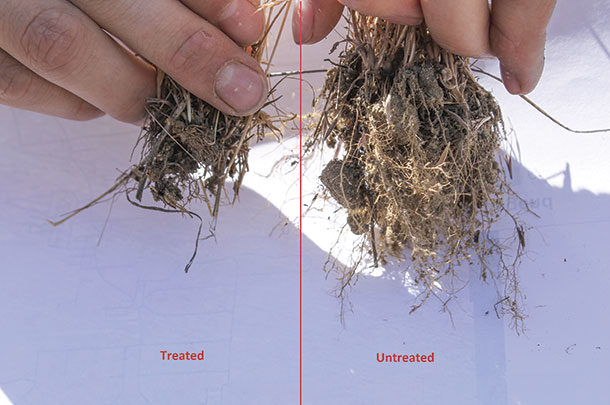Today, with growing concern for environmental health and long-term solutions, there is more interest in biological products, including biofertilizers, biostimulants and biocontrols (bioherbicides and biopesticides) that use microbes as the active ingredient. Angela Lafferty of BioWest Ag Solutions says these natural tools are rapidly gaining a larger share of the market.
The typical way to apply chemical fertilizer is to scatter or spray nutrients on the soil surface, but this isn’t the best place for plant roots to pick them up, and there’s risk for runoff into water sources. “Biological-based fertilizers, soil amendments and soil inoculants are an efficient method to enhance soil and plant health using natural microbial processes to rejuvenate the soil with the macro- and micronutrients that are absent or have been lost,” Lafferty says.
There is a projected significant increase in market share for bioaugmentation, biostimulation, biocontrol products, etc. “Some soil amendments are already registered for use as organic products,” Lafferty says. “Just the market for biopesticides is projected to grow 15 percent by 2022 and be up to $6.6 billion.”
Some microbial isolates are classified as biocontrol agents, such as bioherbicides. “They must go through a detailed process with the EPA to be registered for use. This shows they do no harm, but it takes a long time to go through the EPA process before they can be marketed,” Lafferty says.
As the field of biological products progresses, an integrated approach with all players – growers, land managers, crop consultants and manufacturers – will provide the best results. “Long-term stewardship and sustainability of desired ecosystems is the ultimate goal of any fertility or biological management program. A successful integrated weed management program may include application of both a biological and synthetic control with precise timing and methods together with rehabilitation practices,” Lafferty says.
Biologic control for cheatgrass
Many ranchers and rangeland managers are trying to find ways to halt prolific spread of cheatgrass and medusahead. A new weapon in this battle is the naturally occurring soil bacterium ACK55 that suppresses or inhibits root growth of these invaders. Ann Kennedy, recently retired soil scientist and soil microbiologist with ARS Northwest Sustainable Agroecosystems Research Unit in Pullman, Washington, discovered these helpful bacteria with research that began more than 30 years ago.
Today, her work is continued by Mark Weltz and others at the ARS-Great Basin Rangelands Research Unit in Reno, Nevada. This bacterial herbicide may soon be available.
“In late February, we completed the last EPA-required analysis and evaluation of ACK55 as a bioherbicide,” Weltz says. “We’re now waiting to see if they need any additional information after they review the application before we know if it can be used on rangelands.”
“I inherited this project from Dr. Kennedy when she retired, since I am in Nevada, the epicenter of cheatgrass problems in the West; our lab had already promised to work with Ann on field-scale trials,” Weltz says. “We are working with BLM (Bureau of Land Management) and several ranchers who have agreed to allow us to test it under different soil and climate interactions to evaluate efficacy. This will be the last step before we can make recommendations on how, when and where ACK55 could be applied.”
Other biological controls
ARS entomologist Brian Rector is working on a major research project looking at biological control. He spends six months each year working with the International ARS lab in Montpellier, France. His mission is targeting pathogens, insects or other destructive agents that impact agriculture which come to the U.S. from that part of the world.
Rector has been working in France trying to find natural enemies for medusahead and has some test candidates (mites) showing promise as being host-specific.
“It will take a little more time before we can put another package together to get through APHIS (Animal and Plant Health Inspection Service) to get more mites imported to the ARS Quarantine here in the U.S. The first set of mites brought to the Quarantine Laboratory at the Western Regional Research Center died following a limited amount of testing. The researchers will try to ship more mites and retry the process. Each attempt is a learning experience. We hope to have another biological control for medusahead in the near future,” he says.
Other bioherbicides
Rector has also been working with a white rust that attacks tall whitetop, an invasive weed, also called ironweed, heart-podded hoary cress or perennial pepperweed (Lepidium latifolium). Native to southern Europe and western Asia, it has become established in many parts of the U.S., including Nevada. Many Western states have declared it a noxious weed. This perennial grows on bare ground, wet areas, ditches, roadsides and croplands, including alfalfa fields.
Working with the Nevada Department of Agriculture, Rector found a white rust that inhibits this weed and reduces its competitiveness. If this project goes forward, it could be another bioherbicide.
The white rust (in the areas it occurs) has limited impact on tall whitetop, however, because it infests the plant too late in the season to reduce seed production. “If it could be sprayed on seedlings, it could have a bigger impact. We currently don’t have funds to investigate it further, however, because we are investing everything on cheatgrass control, along with red brome and medusahead,” Weltz says. ![]()
PHOTO: Research test plots for biocontrol of cheatgrass shows the decreased root mass in the treated cheatgrass (left) and untreated cheatgrass (right). Photo provided by BioWest Ag Solutions.
Heather Thomas is a freelance writer based in Idaho.










